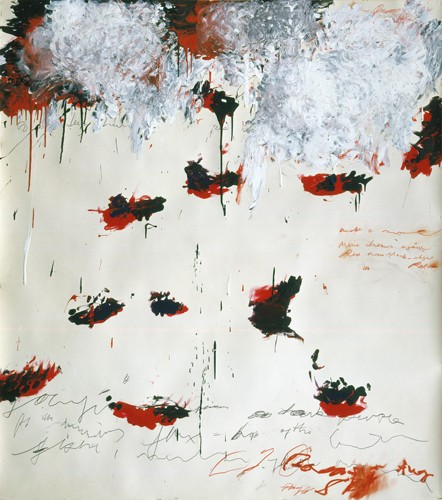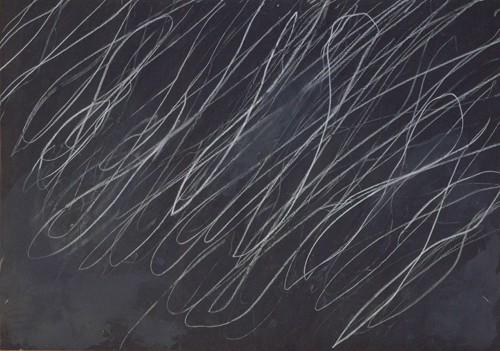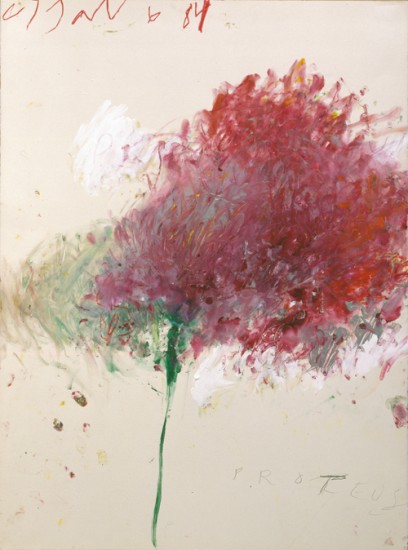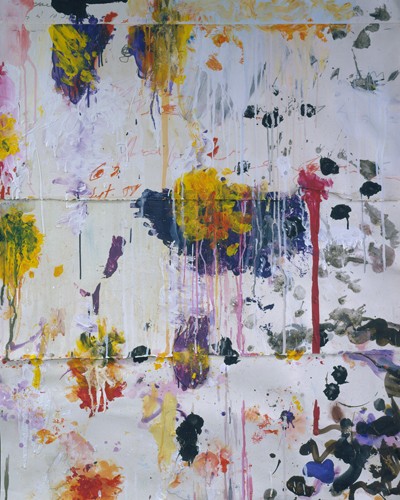Cy Twombly – Fifty Years of Works on Paper
May 23 (Saturday) – August 30 (Sunday), 2015

Petals of Fire, 1989 144 x 128 cm acrylic paint, oil stick, pencil, color pencil on paper
© Cy Twombly Foundation / Courtesy Cy Twombly Foundation
The Hara Museum of Contemporary Art is proud to present the first major solo exhibition in Japan by Cy Twombly, one of the titans of twentieth-century art. Featuring some 70 drawings, paintings and monotypes(1) done on paper from 1953 to 2002, this retrospective spans 50 years of Twombly’s extraordinary career. It was first held in 2003 at the State Hermitage Museum in St. Petersburg(2), organized by Julie Sylvester, the Hermitage’s first non-Russian curator with Cy Twombly himself taking part in the selection of the artwork. Although the artist sadly passed away in 2011, the present show was made possible by the cooperation of the Cy Twombly Foundation which participated in all aspects of its planning. Although Twombly is represented in a number of museum collections in Japan(3) and has been featured in several group shows(4), the relatively few opportunities to see Twombly’s art in Japan make this present show a long anticipated event by Japanese audiences.
A number of works by Cy Twombly will be on display for a limited period at the Kankai Pavilion at Hara Museum ARC, the Hara Museum’s annex in Shibukawa, Gunma prefecture (see “Related Exhibition”). This special shoin-style wing (designed by Arata Isozaki) is normally dedicated to the display of traditional East Asian art from the Hara Rokuro Collection. However, during this period, a number of works by Twombly will be juxtaposed with selected pieces from the collection to promote a dialog that transcends time, culture and space.
Notes:
1. A kind of print that is made by pressing paper to a painted or inked plate made of metal or glass. Unlike other printmaking techniques that produce multiple uniform copies, monotype printing produces only one or two copies.
2. This show later traveled to the Pompidou Center (Paris, 2004), Serpentine Gallery (London, 2004), Pinakothek der Moderne (Munich, 2004),Whitney Museum of American Art (New York, 2005) and Menil Collection (Houston, 2005).
3. The National Museum of Art, Osaka (Osaka)、Benesse House Museum (Kagawa)、Sezon Museum of Modern Art (Nagano)、Kawamura Memorial DIC Museum of Art (Chiba)、Iwaki City Art Museum (Fukushima) and others
4. “The Tenth Anniversary Exhibition / PAINTING 1977 –1987” (The National Museum of Art, Osaka, 1987), “American Art since 1945” (Tochigi Prefectural Museum of Fine Arts, 1988)、″American Painting in the 1950s and 1960s″ (The Museum of Modern Art, Shiga, 1989), “Sonnabend Collection Exhibition” (Sezon Museum of Modern Art, The National Museum of Modern Art, Kyoto and other venues in Japan, 1990), “la collection Yvon Lambert, dialogue avec des artistes contemporains” (Yokohama Museum of Art, 1998), and others.

Untitled, 1970 70.5 x 100 cm wax crayon, house paint on paper © Cy Twombly Foundation / Courtesy Cy Twombly Foundation
【Who Is Cy Twombly?】
Cy Twombly (1928-2011) was one of the most widely admired artists of the 20th century. Both a prolific painter and sculptor, he developed a style of painting that may be best described as painted poetry. Born in the United States, he began dividing his time between the US and Italy from his late 20s. Over the next decades, he quietly cultivated his own unique niche within the art world, aloof from the major art trends. His fame, however, grew on both sides of the Atlantic and spread to the rest of the world, garnering him many honors and awards that included Japan’s Praemium Imperiale in 1996, the Golden Lion Award at the Venice Biennale in 2001 and the Legion of Honor Chevalier Medal in 2010.

Proteus, 1984 76 x 56.5 cm acrylic paint, color pencil, pencil on paper
© Cy Twombly Foundation / Courtesy Cy Twombly Foundation
【Artistic Style】
At the start of Twombly’s career during the early ’50s, the art world was dominated by Abstract Expressionism with Jackson Pollock (1912-56) as one of its central figures. For this reason, Twombly is sometimes seen as a second-generation Abstract Expressionist. The first-generation Abstract Expressionists such as Pollock and Mark Rothko (1903-70), under the direct or indirect influence of Surrealism, incorporated many aspects of automatic writing in their work, such as symbols, markings and various forms both figurative and abstract. Twombly’s spontaneous style, which at first glance appears to be graffiti made by a child, is actually consistent with this early phase of Abstract Expressionism.
Pollock later adopted his famous “action painting” style, while Abstract Expressionism gave way to other styles such as Color Field painting, exemplified by the later work of Rothko. Twombly, however, stuck to his own style, a gestural one in which he applied paint to surface with his bare hands to create images of great energy, spontaneity and sensuality. After transferring his base to Rome in 1957, he continued to distance himself even as American art branched into Pop Art and Minimalism during the ’60s. In a sense, Twombly may be seen as having incorporated the qualities of Pollock’s action painting into the development of his own style while standing “outside” of the American mainstream.
After moving to Rome, Twombly found inspiration in the myths, history and literature (from ancient to modern times) of the Mediterranean. His themes also included the landscape around him, which he interpreted in his own unique manner. Twombly’s paintings and drawings were constructions made up of improvised lines, spattered paint, letters, numbers and symbols (including snippets of verse), combined in seemingly random fashion with a unique use of space. Although seemingly lacking in order, these images could be likened to painted poetry.

Untitled, 2001 124 x 99 cm acrylic paint, wax crayon, pencil, collage on paper
© Cy Twombly Foundation / Courtesy Cy Twombly Foundation
【Critical Assessment】
Twombly worked in relative obscurity until the end of the 1970s when his career reached a turning point. The Whitney Museum of American Art held a retrospective of his art in 1979 and Yvon Lambert(5) published a catalogue raisonné of his works on paper in the same year, which contained an essay on Twombly by Roland Barthes, the renowned French philosopher-critic. His fame became even more international during and after the 1980s. He held a retrospective exhibition at the Museum of Modern Art, New York (MoMA) in 1994, followed by another in 1995 at the Menil Collection Museum in Houston, Texas in the newly completed Cy Twombly Gallery, an annex designed by Renzo Piano as a venue dedicated to Twombly’s art. During his last years, Twombly’s renown was further validated by the many awards he received such as the Praemium Imperiale in Japan (1996), the Golden Lion Award at the Venice Biennale (2001) and the Legion of Honor Chevalier Medal (2010) in France.
Note 5. Yvon Lambert: Catalogue raisonné des oeuvres sur papier de Cy Twombly (Milan, 1979) which included the essay The Wisdom of Art by Roland Barthes.
【Exhibition Details】
Title: Cy Twombly – Fifty Years of Works on Paper
Dates: May 23 (Saturday) – August 30 (Sunday), 2015
Venue: Hara Museum of Contemporary Art 4-7-25 Kitashinagawa, Shinagawa-ku, Tokyo 140-0001
Tel: 03-3445-0651 E-mail: info@haramuseum.or.jp Website: http://www.haramuseum.or.jp
Mobile site: http://mobile.haramuseum.or.jp Blog: https://www.art-it.asia/en/u/HaraMuseum_e
Twitter: http://twitter.com/haramuseum (in Japanese only / account name: @haramuseum)
Organized by: Hara Museum of Contemporary Art, Hara Museum Fund
In collaboration with: Cy Twombly Foundation
Supported by: Terra Foundation for American Art
Special grant provided by: U.S. Embassy, Tokyo
Cooperation provided by: The Bank of Tokyo-Mitsubishi UFJ, Ltd.
Number of works: approx. 70
Hours: 11:00 am – 5:00 pm, Wednesdays until 8:00 pm (last entry 30 minutes before closing)
Closed: Mondays (except July 20) and July 21
Admission: General 1,100 yen; Students 700 yen (high school and university) or 500 yen (elementary and junior high); Free for Hara Museum members, students through high school every Saturday during the school term; 100 yen discount per person for groups of 20 or more.
Directions to the museum: 5 minutes by taxi or 15 minutes on foot from JR Shinagawa Station (Takanawa exit); or from the same station take the No.96 bus, get off at the first stop (Gotenyama), and walk 3 minutes
Terra Foundation for American Art
The Terra Foundation for American Art is dedicated to fostering exploration, understanding, and enjoyment of the visual arts of the Unites States for national and international audiences. Recognizing the importance of experiencing original works of art, the foundation provides opportunities for interaction and study, beginning with the presentation and growth of its own art collection in Chicago. To further cross-cultural dialogue on American art, the foundation supports and collaborates on innovative exhibitions, research, and educational programs. Implicit in such activities is the belief that art had the potential both to distinguish cultures and to unite them.
【Related Event】
Meet the Curator: Cy Twombly – Fifty Years of Works on Paper (Reservation required)
Date: May 23 (Saturday), 2015 2:00 – 4:00 pm
Place: The Hall at the Hara Museum of Contemporary Art(Languages: English/Japanese)
Speakers: Julie Sylvester (Cy Twombly Foundation), Atsuo Yasuda (Curator, Hara Museum of Contemporary Art)
Fee: General 1,000 yen (museum admission required); Free for Hara Museum members (fee required for accompanying guests)
How to make a reservation: Please send an email as follows: write “Event Cy Twombly” on the subject line and your name, Hara Museum membership number (if you are a member) and phone number in the body of the email. Then send the email to: event@haramuseum.or.jp
※ Information about other events will be posted on the Hara Museum website as they are decided.
Lecture and Video Screening by Stephen Sarrazin
“Video and Painting, how the screen was not a canvas”
Date: June 20 (Saturday), 2015 2:00 – 4:00 pm
Languages: English with Japanese interpretation
Fee: General: 1,500yen (museum admission required); Hara Museum members and guests: 1,000yen
*For reservations, please send email to: event@haramuseum.or.jp
or call the museum at: 03-3445-0669
This lecture, accompanied by a screening of selected video works, examines the different relationships between the medium of video and painting and its history. From attempting to achieve painterly analogue textures to the emergence of digital ‘painting’ devices onto borrowing from and commenting on the works of major figures, video and media art has sought to locate itself outside of painting while maintaining a constant dialogue with it. The screening will include discussion of works by Bill Viola, Robert Cahen, Hans Op de Beeck, Pascal Lievre, John Sanborn, Jean-Paul Fargier and Mako Idemitsu.
Speaker: Stephen Sarrazin
Mr. Sarrazin is a film and moving image/media art professor, critic and curator working in Tokyo and Paris. He lectures at Paris 8 University, and at other institutions in Tokyo. He has also guest-lectured at Columbia University, New York University, Buffalo University, Ontario College of Design, as well as in European institutions.
Talk by Akira Tatehata
A related event to the exhibition Cy Twombly – Fifty Years of Works on Paper, Akira Tatehata, who describes himself as Cy Twombly’s “biggest fan,” will give a talk telling us why.
Lecturer: Akira Tatehata (President of Tama Art University / Director of The Museum of Modern Art, Saitama / Poet)
Date: July 11 (Saturday), 2015 2:00 – 4:00 pm
Venue: The Hall at the Hara Museum of Contemporary Art
Fee: General 1,500yen (museum admission required); Hara Museum members and guests 1,000yen
*This event will be given in Japanese only.
For reservations, please send email to: event@haramuseum.or.jp
or call the museum at: 03-3445-0669
【Related Exhibition】
Line and Space: Cy Twombly and East Asia
May 29 (Friday) – September 2 (Wednesday), 2015
Kankai Pavilion at Hara Museum ARC
2855-1 Kanai, Shibukawa-shi, Gunma 377-0027
The Kankai Pavilion (designed by Arata Isozaki) provides a Japanese-style setting for the viewing of traditional East Asian art. For this exhibition, several works by Cy Twombly will be juxtaposed with a selection of East Asian artworks to engender an aesthetic dialogue that transcends time, space and the dichotomy between East and West. (For museum hours and access, please refer to the Hara Museum website at http://www.haramuseum.or.jp).
※ All exhibited works owned by the Cy Twombly Foundation. © Cy Twombly Foundation / Courtesy Cy Twombly Foundation
